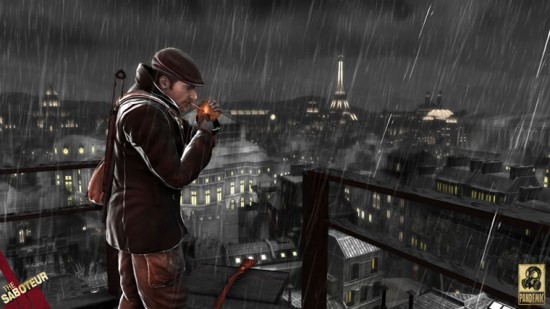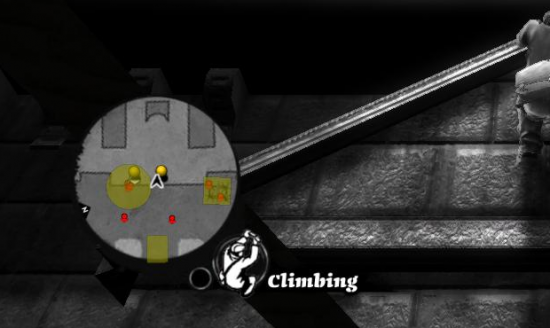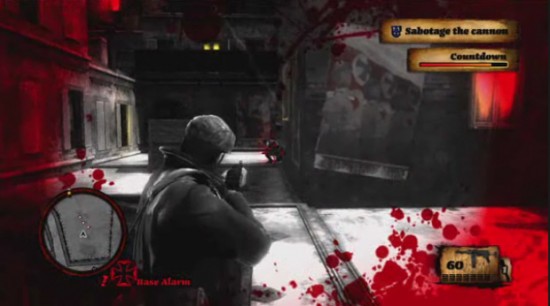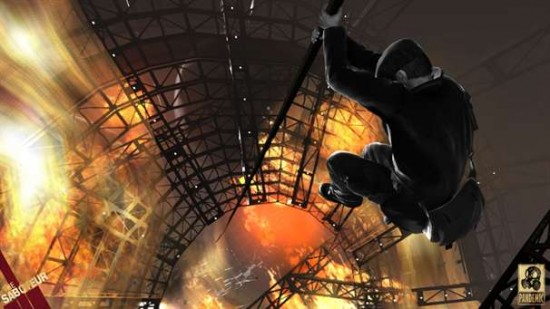The Saboteur is an open-world action adventure game set in the Nazi-occupied Paris of World War II. It was released late last year to mixed reviews and lackluster sales under the shadow of Assassin’s Creed II and the dozens of other holiday releases that had actual marketing budgets. Some players say it’s unfinished and buggy, which is pretty much on the mark – Pandemic was shut down before the game’s launch, so it went out the door without the extra layer of polish that makes good games great.
I picked it up with low expectations, and came away 60 hours later thoroughly impressed. Players willing to look beyond the problems can still find a satisfying experience inside – not to say they should because it has a lot of problems, but it shouldn’t be completely dismissed either. It’s a good candidate for a deconstruction because the unpolished mechanics strewn throughout the game are representative of amazing ideas that remain unexplored by other open world games.
The Saboteur
Developer: Pandemic Studios
Publisher: Electronic Arts
Genre: Open World / Stealth Action
Metacritic: 72
Price: $59.99 on release, $19.99 at the time of writing
The bulk of Saboteur’s gameplay consists of destroying targets that weaken the Nazi presence in the city such as observation towers, armored vehicles, and artillery encampments. The sheer number of targets around the city is unprecedented – looking at a map of them at the beginning is nothing short of intimidating. Some players might be turned off by the breadth of things to do, but it reinforces the setting by making the French Resistance feel smaller than any sort of dialog could.
Story missions are strewn throughout the game and do everything you’d expect in an open world game. They’ll take place in one-off, linear levels, but most of the time they’re just about navigating from point A to point B on the world map, occasionally blowing something up along the way. There’s nothing particularly bad about this system, but nothing great either.
The defining characteristic of Saboteur is its stealth gameplay. Players are tasked with sneaking into bases and planting bombs over and over again. It’s a big system, so let’s break it down:
The game’s map is divided into three types of areas: “normal zones,†“suspicion zones,†and “restricted zones.†In normal zones, Sean can walk around right in front of Nazi officers without them minding. These are the areas where the people of Paris are out on the streets. In suspicion zones (indicated by yellow on the map), enemies will slowly become suspicious when they see Sean. In restricted zones (indicated by red on the map), enemies will almost instantly trigger an alert when they see Sean.
Alerts follow the GTA system of escaping the highlighted area on the minimap. The area’s size doubles with each alert level. After alert level three (of five), “fight back†points appear on the map that act as a sort of last-stand where NPCs assist the player at an intersection to fend off Nazis from all sides. After eliminating enough enemies, the alert phase ends. There are also hiding spots throughout the city that can be used to end the lower alert levels, such as brothels and bathrooms.
The player’s suspicion level is indicated by a yellow ring around the player’s weapon on the UI. It drops at a constant rate, but increases at different rates depending on the player’s actions. Climbing a building or walking into a Nazi is always suspicious, and driving over one will instantly trigger an alert. Running while in a suspicion zone will cause the meter to increase much faster than walking. Enemies that see the player doing suspicious things are outlined in yellow so the player knows where suspicion increase is coming from.
The player can also use stealth kills on Nazis to steal their uniforms, allowing free exploration of suspicion zones. Climbing and running, however, are still suspicious, and the player can’t get too close to enemies for an extended period of time. Disguises disappear whenever an alert is triggered, and they aren’t an inventory item.
Lots of critics complained that the stealth system felt too “gamey.†I’m not entirely sure I understand the concept of a game being too much of a game, but to be fair, let’s look Metal Gear Solid and Splinter Cell, widely accepted as the best modern stealth-action franchises, to get an idea of what a “good†stealth system looks like.
When enemies spot the player in Metal Gear Solid, they audibly say something like “HUH? WHAT WAS THAT?†and begin walking in the player’s direction. Various factors affect how fast the player is spotted, such as light versus dark hiding places or crawling versus standing. Making noise is bad too – unless the player uses a silenced weapon, enemies will hear gunshots. After a couple seconds of being visible, the famous exclamation point appears above the enemies’ heads and they begin shooting, triggering an “alert†phase where all enemies in the area will start moving in the player’s direction. If players just run through a room full of guards, they’re almost certain to be seen. There also aren’t any safe areas – guards will always attack them when they see them. Players are equally rewarded for stealth kills and shooting wildly, but most players choose to play it as a stealth game because most of the mechanics are designed for stealth.
Splinter Cell has similar light/dark and noise mechanics, but rewards stealth over action. It’s possible (and often encouraged) to proceed through large sections of the game without killing anyone.
In both games, players must run away, hide, and wait a certain period of time after being spotted. During this waiting period (often called the “suspicion periodâ€), the game’s enemies will actively search the level until they either find the player (retriggering the alert phase) or the timer on the waiting period runs out. After that, they go back about their business as usual.
Whereas it can be frustrating to sit in the same place waiting for an alert to end in Metal Gear Solid and Splinter Cell, Saboteur empowers players by making them responsible for ending an alert rather than being the mercy of the AI’s pathfinding. This doesn’t mean that the systems in Splinter Cell or Metal Gear Solid are poorly designed: they serve to encourage players to use stealth. If I know I’m going to have to sit still for sixty seconds every time an enemy sees me, I’m going to make damn sure I don’t get seen. You simply cannot offer a good run-n-gun experience when half the buttons on your control scheme are reserved for stealth-related actions, so it makes sense to encourage players to use stealth most of the time.
This is a problem for The Saboteur. The game is forgiving enough that it allows players to play it like a shooter rather than a stealth game. Regardless of the difficulty level, you can shoot your way through almost any situation if you don’t want to use stealth, and it’s always the easier option. The run-away-reset system isn’t bad on its own, and it’s been proven to work in an open-world environment, but the game offers nothing to reward you for using stealth beyond a handful of achievements. Players are going to go for goals whenever they see them, and if the easiest way is to shoot their way to a target, that’s the route they’ll take most of the time.
When played as a run-n-gun, the reset system has the opposite of its intended effect: players now must take a break from their shooting to run away from the action and reset the alert meter so they can deal with a manageable number of enemies in the area. It becomes a game of inching forward and resetting rather than a game of continuous progress.
Maybe this is what the critics who cried “gamey†really meant. The stealth system would likely come across as being overly arbitrary when players breeze through Saboteur like an action game. Maybe we inherently expect a penalty for being discovered when we’re sneaking around through some basic understanding of “stealth†beyond traditional game mechanics. Saboteur’s systems aren’t all that different from the games that critics love, but they were perceived as being poorly implemented. That means the problem lies with balancing in the other mechanics that present the stealth system, such as player health and firepower.
If the majority of your game’s design is geared towards stealth, it should almost always encourage players to choose stealth as their first option for any given situation.
Some people love the run-n-gun gameplay popularized in GTA and Mercenaries, so it’s likely Pandemic (or EA) management that wanted the studio to stay somewhat true to its roots. I see this as a missed opportunity for Pandemic to separate itself from the competition – if the bigger part of the game required players to use stealth and plant bombs, it might have ended up appealing to the Splinter Cell or Metal Gear Solid audience. As it was implemented, it fell into the crowded GTA wannabe genre and went unnoticed in the holiday-release window.
It might sound like I’m talking about Assassin’s Creed now. The games have a lot of similarities – most notably in their climbing / parkour systems – but they feel very different. Assassin’s Creed is much more structured. I recently played through Assassin’s Creed Brotherhood, an absolutely fantastic game by all accounts, and the story missions blow Saboteur out of the water in terms of production value, plot, and gameplay variety. The bulk of Saboteur’s gameplay, however, lies in its freeplay missions (or sidequests / collect-a-thon compulsions). Whereas Assassin’s Creed has you running after flags and feathers on rooftops, Saboteur has you blowing shit up. I found the latter to be more satisfying. To top it off, there are more sabotage targets in Saboteur than there are flags in the first three Assassin’s Creed games combined (which you should know is a lot of targets if you’ve played an Assassin’s Creed game).
To continue the comparison, the climbing mechanics in Saboteur feel much slower than in Assassin’s Creed, and a lot of critics complained about that too. Assassin’s Creed does the work for you – hold the free run button and approach a climbable object to climb up. In Saboteur, you run up to an object, press the jump button, then press the grab button, and move the joystick around to select the next ledge you want to jump to. You then press the jump button and repeat for every subsequent ledge until you reach the top. It’s a lot more work and it doesn’t feel anywhere near as elegant as Assassin’s Creed, Prince of Persia or Uncharted.
I see this difference as being similar to the Metal Gear Solid / Splinter Cell alert-reset waiting period problem. Assassin’s Creed is much more fast-paced than Saboteur, so a fast climbing system makes sense for players who just want to get from mission to mission. In Saboteur, climbing up certain buildings are often missions in themselves for knocking out freeplay targets. The player has to think more, and in turn, prepare a strategy before attempting to scale it. Maybe it doesn’t feel as cool as Assassin’s Creed, but it isn’t necessarily a bad design. I think there’s room for both systems to work. In fact, I would argue that if Saboteur had put more of a focus on stealth (if even by lowering the player’s health), players would have been more open to the climbing system. It can feel more rewarding when the player does actual work to reach a goal. Unfortunately, the slow pace feels really out of place when the game is played as a run-n-gun, and that seems to be how most people played it.
The gameplay as a whole suffers from Steve Jobs syndrome: if you think it’s bad, you’re probably holding it wrong. That’s not the consumer’s fault – there’s no wrong way to hold a great game – but as curious developers, we should at least be able to impose artificial constraints on the way we play a game to have the best possible experience and learn from it.
Closing
At the end of the day, I want a stealth-action game to make me feel like a badass. Show me another game where I can climb up into an enemy watchtower, hop on an anti-air turret, shoot a zeppelin out of the sky, set a bomb, and make my escape before watching an oppressed people celebrate when they see the explosion. That was the vision of Saboteur, and you can still experience it if you give the game a try. It’s a prime example of good game design that could have been great, and it’s a real shame that Pandemic didn’t get extra time to figure those problems out.






Metal Gear Solid Ground Zeroes Trailer – YouTube